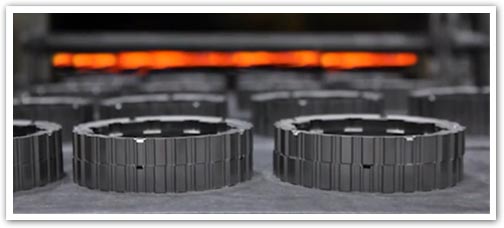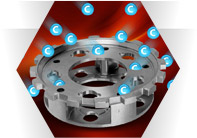Heat Treating
Added Strength, Unique Expertise
Sintered powdered metal parts can undergo heat treating operations to optimize properties such as strength and hardness.
Keystone began heat treating powdered metal parts in the 1940's, and in 1949 was the first company to steam treat a sintered PM part. In the mid-1960's, we added induction heat treating for gears. In the decades since, we have refined these processes to hold better tolerances while retaining the properties of the heat treated part.
Unlike most powdered metal manufacturers, we perform all of our heat treating services in-house. This gives us complete control over our processing, enabling us to customize our methods to suit the product specifications. It can also contribute to lower production costs and faster delivery times.

We offer the full spectrum of heat treating services to suit any application:
Neutral Hardening
Neutral hardening involves heating parts in a carbon neutral atmosphere and then quenching to increase the strength and hardness of the part. This process is used on medium to high carbon containing ferrous parts.
 Carburizing
Carburizing
We use gas carburizing to increase the carbon content of the part's surface, thus increasing strength and hardness of the surface of the PM part. This process uses low carbon containing ferrous parts. The porosity of the PM component affects the depth of carbon penetration: the lower the density, the greater the carbon penetration. Defined carburized case depths are difficult to achieve until the density is 7.1 g/cc and greater.
Carbonitriding
Carbonitriding is similar to carburizing but relies on both carbon and nitrogen to alloy with the ferrous parts to increase the surface hardness. Defined carbonitrided layers are generally not obtained until the density of the component exceeds 7.1 g/cc, due to the porosity of the PM component.
Induction Heat Treating
Induction heat treating is a selective surface heat treating process that uses magnetic fields to heat the surface of the PM part. Medium to high carbon containing ferrous materials are used in this operation to increase the strength and wear resistance of gears, splines, and sprockets. Keystone has developed induction heat treaters for hardening external and internal gear geometries.
Keyonyx (Steam Treating)
Keyonyx is Keystone’s trade name for steam treating. During the Keyonyx process, the component is heated to a low process temperature (480°C – 593°C) (900°F–II00°F) and then exposed to a steam atmosphere. The steam reacts with the ferrous parts to form an oxide layer on the surface and in the pores. The oxide is predominately Fe2O3. The typical steam treat layer is 0.0001" to 0.0002" in thickness. The hardness of the steam oxide is HRC50. Keyonyx improves surface hardness and corrosion resistance. It is a low temperature/low distortion process.
Tempering
Tempering is performed on all heat treated components. Components in the as-heat treated state tend to be brittle. Tempering increases the toughness without sacrificing the wear resistance of the component.
When you source from Keystone, we will define a process plan with the appropriate heat treating operations to meet your product requirements.
Contact us to discuss the ideal heat treating services for your powdered metal products.

